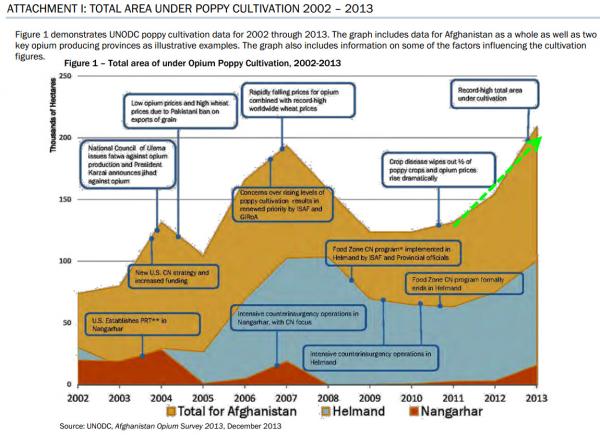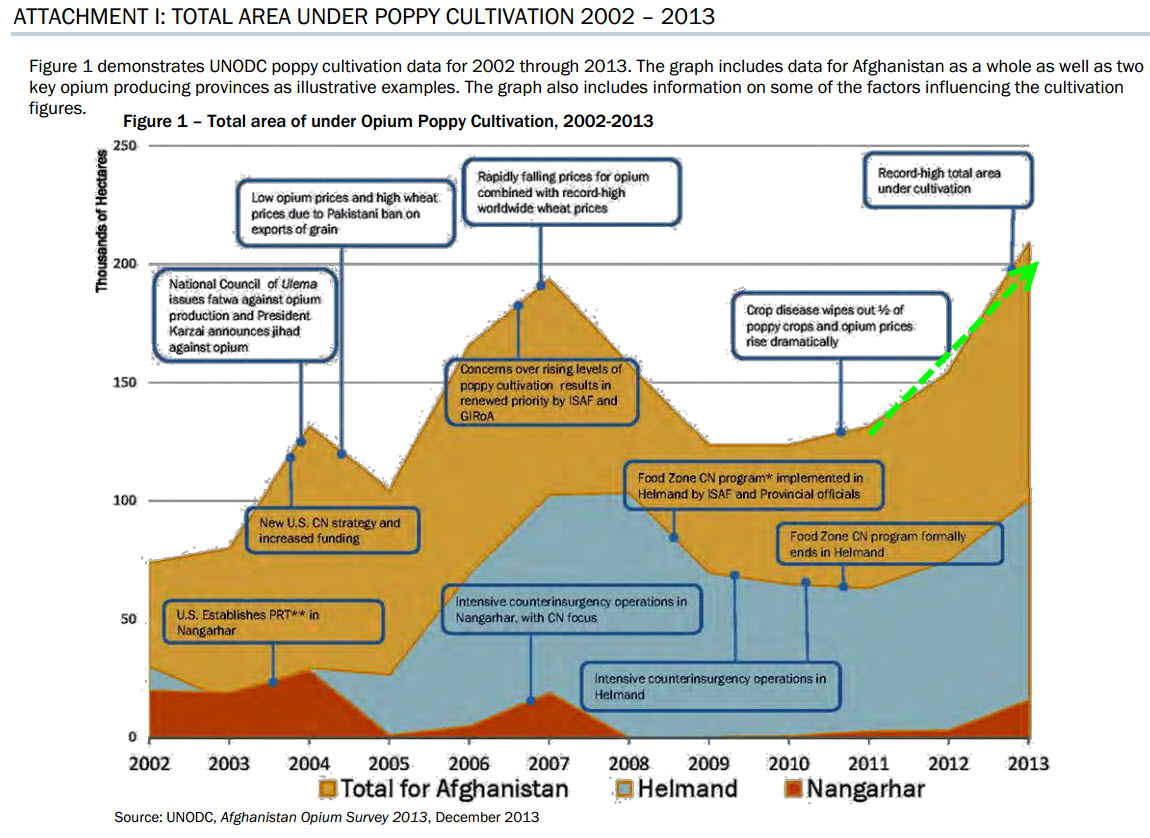
7.6 BILLION REASONS WHY THE US 'WAR ON DRUGS' IN AFGHANISTAN FAILED
Tyler Durden
The US Embassy in Kabul, Afghanistan is "disappointed," according the statement department latter below, responding to the Special Investigator General for Afghanistan Reconstruction (SIGAR) findings [4] over poppy cultivation in the troubled nation. Simply put, despite the United States spending approximately $7.6 billion on counternarcotics efforts in Afghanistan (as of June 30, 2014), opium poppy cultivation levels in Afghanistan hit an all-time high in 2013 (with a 50% rise last year alone). Of course, like any good government agency, deny and blame someone else, as the DOD went on to state that "the failure to reduce poppy cultivation and increase eradication is due to the lack of Afghan government support for the effort."
PLEASE SCROLL DOWN
*
*
*
*
*
*
*
*
*
*
Poppy Cultivation hits an all-time high - despite counternarcotics spend by the US government of $7.6bn!!
From SIGAR,
Dear Secretary Kerry, Secretary Hagel, Attorney General Holder, and Administrator Shah:
I am writing to provide the results of SIGAR’s analysis of recent trends in opium poppy cultivation in Afghanistan. As you know, the narcotics trade poisons the Afghan financial sector and undermines the Afghan state’s legitimacy by stoking corruption, sustaining criminal networks, and providing significant financial support to the Taliban and other insurgent groups. Despite spending over $7 billion to combat opium poppy cultivation and to develop the Afghan government’s counternarcotics capacity, opium poppy cultivation levels in Afghanistan hit an all-time high in 2013.
According to the United Nations Office on Drugs and Crime (UNODC), Afghan farmers grew an unprecedented 209,000 hectares of opium poppy in 2013, surpassing the previous peak of 193,000 hectares in 2007. With deteriorating security in many parts of rural Afghanistan and low levels of eradication of poppy fields, further increases in cultivation are likely in 2014.
As of June 30, 2014, the United States has spent approximately $7.6 billion on counternarcotics efforts in Afghanistan. Multiple sources of funding support these efforts, including the Department of Defense (DOD) Afghan Security Forces Fund, the State Department's (State) International Narcotics Control and Law Enforcement fund, the DOD Drug Interdiction and Counter-Drug Activities fund, financial support from the U.S. Drug Enforcement Administration, and the U.S. Agency for International Development’s Economic Support Fund. Counternarcotics efforts include the development of Afghan government counternarcotics capacity, operational support to Afghan counternarcotics forces; encouragement of alternative livelihoods for Afghan farmers; financial incentives to Afghan authorities to enforce counternarcotics laws; and, in limited instances, counternarcotics operations conducted by U.S. authorities in coordination with their Afghan counterparts.
Despite the significant financial expenditure, opium poppy cultivation has far exceeded previous records. Affordable deep-well technology has turned 200,000 hectares of desert in southwestern Afghanistan into arable land over the past decade. Due to relatively high opium prices and the rise of an inexpensive, skilled, and mobile labor force, much of this newly-arable land is dedicated to opium cultivation. Poppy-growing provinces that were once declared 'poppy free' have seen a resurgence in cultivation. Nangarhar province in eastern Afghanistan, considered a model for successful counterinsurgency and counternarcotics efforts and deemed ‘poppy free’ by the UNODC in 2008, saw a fourfold increase in opium poppy cultivation between 2012 and 2013. The UNODC estimates that the value of the opium and its derivative products produced in Afghanistan was nearly $3 billion in 2013, up from $2 billion in 2012. This represents an increase of 50 percent in a single year.
Who is to blame?
For its part, DOD acknowledged the significance of increased opium poppy cultivation in Afghanistan, and that “poppy production is on the increase and is a significant threat to U.S. and international efforts in Afghanistan.” Like the Embassy Kabul response, DOD highlighted its efforts and those of other U.S. government agencies to build a “reliable Afghan counterdrug partner and enduring Afghan [counternarcotics] capacity.” However, DOD went on to state that “the failure to reduce poppy cultivation and increase eradication is due to the lack of Afghan government support for the effort."
The State Department is disappointed:
* * *
Once again, government efficiency exposed.
Links:
[1] http://www.zerohedge.com/users/tyler-durden
[2] http://www.zerohedge.com/taxonomy_vtn/term/11780
[3] http://www.zerohedge.com/taxonomy_vtn/term/10021
[4] http://www.sigar.mil/pdf/Special%20Projects/SIGAR-15-10-SP.pdf
[5] http://www.zerohedge.com/sites/default/files/images/user3303/imageroot/2014/10-overflow/20141022_poppy1.jpg
[6] http://www.zerohedge.com/sites/default/files/images/user3303/imageroot/2014/10-overflow/20141022_poppy2.jpg
http://www.zerohedge.com/print/496076



